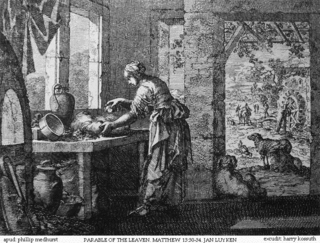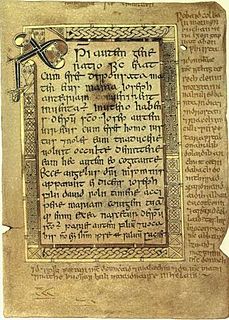Related Research Articles

Mark 11 is the eleventh chapter of the Gospel of Mark in the New Testament of the Christian Bible, beginning Jesus' final week before His death as He arrives in Jerusalem for the coming Passover. It contains the stories of Jesus' entry into Jerusalem, His cursing of the fig tree, His conflict with the Temple money changers, and His argument with the chief priests and elders about his authority.

Matthew 3 is the third chapter of the Gospel of Matthew in the New Testament. It is the first chapter dealing with the ministry of Jesus with events taking place some three decades after the close of the infancy narrative related in the previous two chapters. The focus of this chapter is on the preaching of John the Baptist and the Baptism of Jesus.

Matthew 3:10 is the tenth verse of the third chapter of the Gospel of Matthew in the New Testament. The verse occurs in where John the Baptist is berating the Pharisees and Sadducees. He has previously called them a brood of vipers and warned them of the wrath to come and has urged them to repent. This verse returns to the fruit metaphor of Matthew 3:8 adding a promise of eventual punishment.

Matthew 7:16 is the sixteenth verse of the seventh chapter of the Gospel of Matthew in the New Testament and is part of the Sermon on the Mount. This verse continues the section warning against false prophets.

The Parable of the Sower is a parable of Jesus found in Matthew 13:1–23, Mark 4:1–20, Luke 8:4–15 and the extra-canonical Gospel of Thomas.

The Parable of the Tares or Weeds is a parable of Jesus which appears in Matthew 13:24–43. The parable relates how servants eager to pull up weeds were warned that in so doing they would root out the wheat as well and were told to let both grow together until the harvest. Later in Matthew, the weeds are identified with "the children of the evil one", the wheat with "the children of the Kingdom", and the harvest with "the end of the age". A shorter, compressed version of the parable is found without any interpretation in the apocryphal Gospel of Thomas.

The Parable of the Leaven is one of the shortest parables of Jesus. It appears in Matthew and Luke, as well as in the non-canonical Gospel of Thomas. In the canonicals it immediately follows the Parable of the Mustard Seed, which shares this parable's theme of the Kingdom of Heaven growing from small beginnings, and in the Gospel of Thomas it starts a series of three, preceding the Parable of the empty jar and the Parable of the Strong Man.

Mark 13 is the thirteenth chapter of the Gospel of Mark in the New Testament of the Christian Bible. It contains Jesus' predictions of the destruction of the Temple in Jerusalem and disaster for Judea, as well as his eschatological discourse.

Matthew 21 is the twenty-first chapter in the Gospel of Matthew in the New Testament section of the Christian Bible. Jesus triumphally or majestically arrives in Jerusalem and commences his final ministry before his Passion.

Luke 6 is the sixth chapter of the Gospel of Luke in the New Testament of the Christian Bible. Jesus' teaching about the Sabbath enrages the religious authorities and deepens their conflict. The selection of twelve apostles is recounted and this is followed by the "Sermon on the Plain", where key aspects of Jesus' teaching are presented.

Luke 12 is the twelfth chapter of the Gospel of Luke in the New Testament of the Christian Bible. It records a number of teachings and parables told by Jesus Christ when "an innumerable multitude of people had gathered together", but addressed "first of all" to his disciples. The book containing this chapter is anonymous, but early Christian tradition uniformly affirmed that Luke composed this Gospel as well as the Acts of the Apostles.

Luke 13 is the thirteenth chapter of the Gospel of Luke in the New Testament of the Christian Bible. It records several parables and teachings told by Jesus Christ and his lamentation over the city of Jerusalem. Jesus resumes his journey to Jerusalem which he has embarked upon in Luke 9:51. The book containing this chapter is anonymous, but early Christian tradition uniformly affirmed that Luke composed this Gospel as well as the Acts of the Apostles.

Matthew 7:17 and Matthew 7:18 are the seventeenth and eighteenth verses of the seventh chapter of the Gospel of Matthew in the New Testament and is part of the Sermon on the Mount. This verse continues the section warning against false prophets.

Matthew 7:19 and Matthew 7:20 are the nineteenth and twentieth verses of the seventh chapter of the Gospel of Matthew in the New Testament and are part of the Sermon on the Mount. The verses continue the section warning against false prophets.
Matthew 12:33 is the 33rd verse in the twelfth chapter of the Gospel of Matthew in the New Testament.
Matthew 12:34 is the 34th verse in the twelfth chapter of the Gospel of Matthew in the New Testament.

The Parable of the Budding Fig Tree is a parable told by Jesus in the New Testament, found in Matthew 24:32-35, Mark 13:28-31, and Luke 21:29-33. This parable, about the Kingdom of God, involves a fig tree, as does the equally brief parable of the barren fig tree.
The Parable of the Olive Tree is an extended allegory recounted in Chapter 5 of the Book of Jacob, the third book of the Book of Mormon. Jacob states the allegory was one of the teachings of Zenos found in the brass plates, a lost record. Latter Day Saints suggest that it is possible that Paul in his Epistle to the Romans is referencing a similar parable.

In Christianity, the term Five Discourses of Matthew refers to five specific discourses by Jesus within the Gospel of Matthew.

The following outline is provided as an overview of and topical guide to Wikipedia articles on the life and influence of Jesus.
References
- ↑ Jesus in the first three Gospels by Millar Burrows, 1977 ISBN 0-687-20089-X pages 122 and 195
- ↑ Matthew by Douglas Hare 2009 ISBN 0-664-23433-X page 34
- ↑ Nicoll, W. R., Expositor's Greek Testament on Luke 6, accessed 17 July 2020